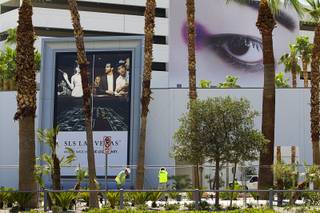
SLS Las Vegas President Rob Oseland will have some unique operational advantages to work with at the new casino resort, slated to open in 2014.
Sunday, Aug. 17, 2014 | 2 a.m.
For many Las Vegans, the Strip is for work, not play — a place whose crowds and often extravagant prices are reserved for special occasions and out-of-town guests.
But SLS Las Vegas wants to change locals’ minds.
Opening at the former Sahara on Aug. 23, the resort hopes to distinguish itself from its Strip peers with a marketing push that caters as much to locals as it does to tourists. A convenient location, diverse dining and entertainment options, and prices touted as being lower than average for the Strip are among the amenities operators hope will resonate with residents. The property also plans to roll out a loyalty program, dubbed “The Code,” that allows customers to use points and rewards at any SLS property.
Catering to locals isn’t new territory for the resort’s parent company, SBE. The demographic has been the bread-and-butter of its popular nightlife and dining venues in Los Angeles, New York and Miami, several of which — such as the Sayers Club music venue and Umami Burger — are being imported to Las Vegas.
“Between our brands and location, catering to locals was a natural fit,” SLS Las Vegas Chief Operating Officer Rob Oseland said. “We knew from the beginning it was an important audience.”
Still, getting locals to Las Vegas Boulevard can be a tough sell. As a high-frequency, low-spending demographic, they are drawn to resorts largely by convenience and approachability, neither of which most associate with the Strip.
“The big challenge is to diffuse the idea that the Strip is a challenge to get to,” said Sarah Tanford, a professor at UNLV’s William F. Harrah College of Hotel Administration. “Beyond that, you need to build relationships and create an emotional attachment. ... Tangible promotions are not enough.”
For many Strip properties, the high cost and low return of marketing to locals isn’t worth the effort. But SLS finds itself uniquely situated — literally.
Flanked by the abandoned Fontainebleau and a 33-acre lot that’s slated to become the Rock in Rio festival grounds, SLS offers the first sign of life in a no-man’s-land section of the north Strip. Its proximity to Interstate 15, Sahara Avenue and Paradise Road provide back-door access to the resort without the hassle of Strip traffic, a factor that helped the Sahara draw a 30 to 40 percent local clientele in its heyday, Oseland said. It’s a legacy he hopes to preserve by reaching out to locals in the suburbs and downtown. Las Vegas’ younger, hipper demographic remains relatively untapped by other properties that cater to locals, he said.
The resort also will offer casual but distinct brands, including a beer garden and noodle house, and seven-day-a-week nightlife venues, such as Foxtail.
The ultimate goal: make the SLS a stop for Strip employees on their way home from work as much as a must-see on tourists’ itineraries.
“It’s a great strategy,” said Stowe Shoemaker, dean of the William F. Harrah College of Hotel Administration at UNLV. “There’s a real uniqueness to the brand and to the property that you don’t find at other places. That will get the person in the door. What will build the loyalty will be the success of the service levels and what’s happening at the property.”


Join the Discussion:
Check this out for a full explanation of our conversion to the LiveFyre commenting system and instructions on how to sign up for an account.
Full comments policy